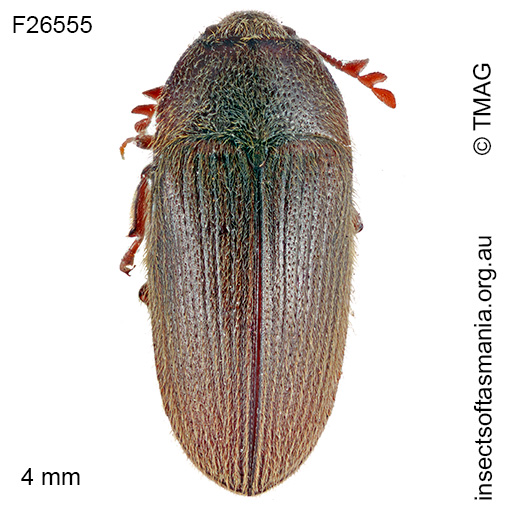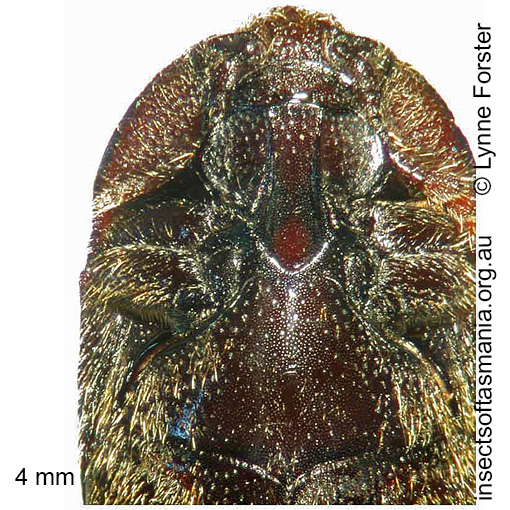
Aulonothroscus elongatus (a species of small-false-click-beetle)
Basis for Tasmanian occurrence
Semmens, T.D., McQuillan, P.B. & Hayhurst, G. (1992). Catalogue of the Insects of Tasmania. Government of Tasmania: Department of Primary Industry, 104 pp. (as Aulonothroscus elongatus)
TMAG collections
Classification
Order: Coleoptera
Suborder: Polyphaga
Superfamily: Elateroidea
Family: Throscidae
Morphology
Typical length (mm): 4
Flightedness: winged and assumed capable of flight
Ecology
Assumed larval feeding: fungus-feeder
Association with dead wood or old trees: obligately saproxylic
Ecological attributes: — Affiliated with bark on non-wounded trees (Harrison, 2007) — Affiliated with larger-diameter logs (Yee et al., 2006) — Affiliated with older trees (Harrison, 2007) — May occupy logs or trunks of Eucalyptus obliqua, at least temporarily, since found having emerged within a year of felling (Grove & Bashford, 2003) — May occupy logs or trunks of Eucalyptus obliqua, at least temporarily, since found having emerged within six years of felling (Grove et al., 2009).
Collection method(s) for TMAG material: — At light (with use of light-trap) — Baited trapping (funnel trap) — Emergence trapping from cut billets of Eucalyptus obliqua (Harrison, 2007) — Emergence trapping from log of Eucalyptus obliqua — Flight intercept trapping (trough below Malaise trap) — Hand collection (substrate not specified) — Hand collection from under bark of Eucalyptus pulchella — Knockdown fogging of canopy of Eucalyptus obliqua — Knockdown fogging of canopy of Nothofagus cunninghamii — Knockdown spraying of bark of Eucalyptus obliqua — Knockdown spraying of bark of Eucalyptus sp. — Malaise trapping — Pipe trapping — Pitfall trapping — Sticky trapping on Eucalyptus obliqua — Sticky trapping on Eucalyptus ovata — Sticky trapping on Eucalyptus viminalis — Trapping using a range of devices placed in crown of Eucalyptus obliqua (Bar-Ness, 2005) — Vane trapping.
Source ecological literature:
Grove, S.J. & Bashford, R. (2003). Beetle assemblages from the Warra log decay project: insights from the first year of sampling. Tasforests 14: 117-129.
Grove, S.J. (2009b). Beetles and fuelwood harvesting: a retrospective study from Tasmania’s southern forests. Tasforests 18: 77-99.
Hopkins, A.J.M. et al. (2005). Wood decay fungi and beetle assemblages associated with living Eucalyptus obliqua trees: early results from studies at the Warra LTER Site, Ta
Baker, S.C. (2006b). Ecology and conservation of ground-dwelling beetles in managed wet eucalypt forest: edge and riparian effects. PhD thesis, Univ. of Tasmania, Hobart.
Bar-Ness, Y. (2005). Crown structure and the canopy arthropod biodiversity of 100 year old and old-growth Tasmanian Eucalyptus obliqua. Msc thesis, Univ. of Tasmania, Hobart.
Bar-Ness, Y.D. et al. (2006). Age and distance effects on the canopy arthropod composition of old-growth and 100-year-old Eucalyptus obliqua trees. For. Ecol. Manage. 226: 290-298.
Grove, S. et al. (2009). A long-term experimental study of saproxylic beetle … succession in Tasmanian Eucalyptus … logs… In: Fattorini, S. (Ed.), Insect Ecology and Conservation. Research Signpost, pp. 71-114.
Grove, S.J. & Yaxley, B. (2005). Wildlife habitat strips and native forest ground-active beetle assemblages in plantation nodes in northeast Tasmania. Aust. J. Entom. 44 (4): 331-343.
Harrison, K.S. (2007). Saproxylic beetles associated with habitat features in Eucalyptus obliqua trees in the southern forests of Tasmania. PhD thesis, Dept. of Zoology, Univ. of Tasmania, Hobart.
Yee, M. (2005). The ecology and habitat requirements of saproxylic beetles native to Tasmanian wet eucalypt forests: potential impacts of commercial forestry practices. PhD thesis, Univ. of Tasmania, Hobart.
Yee, M. et al. (2006). Brown rot in inner heartwood: why large logs support characteristic … beetle assemblages … In Grove, S.J. & Hanula, J.L. (eds.) Insect biodiv. and dead wood, pages 42-56. USDA For. Serv., SRS.


